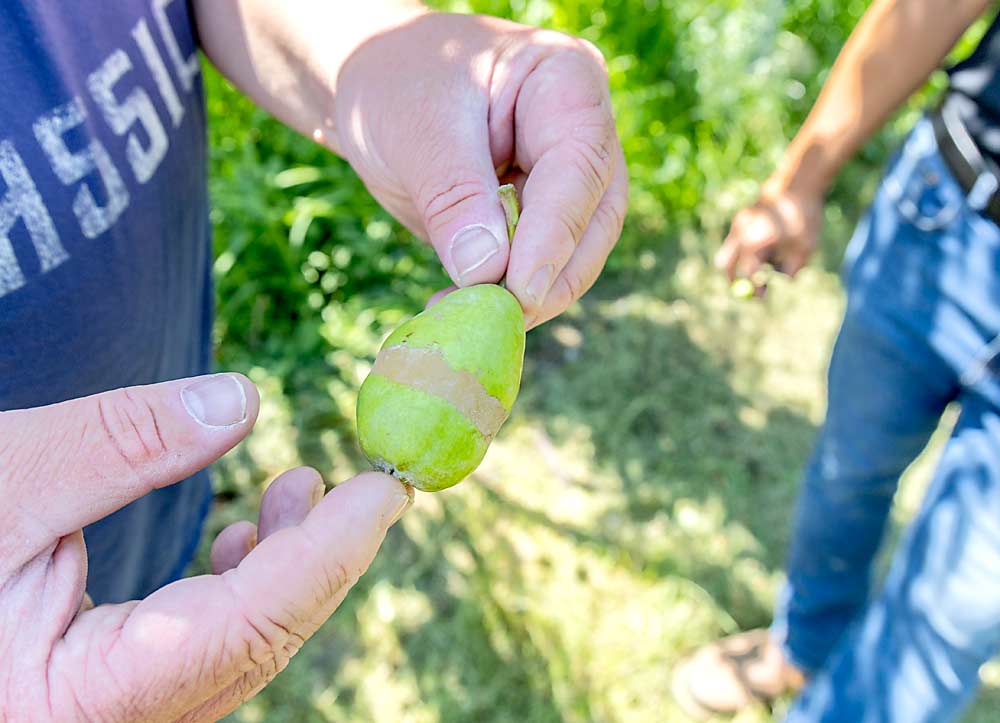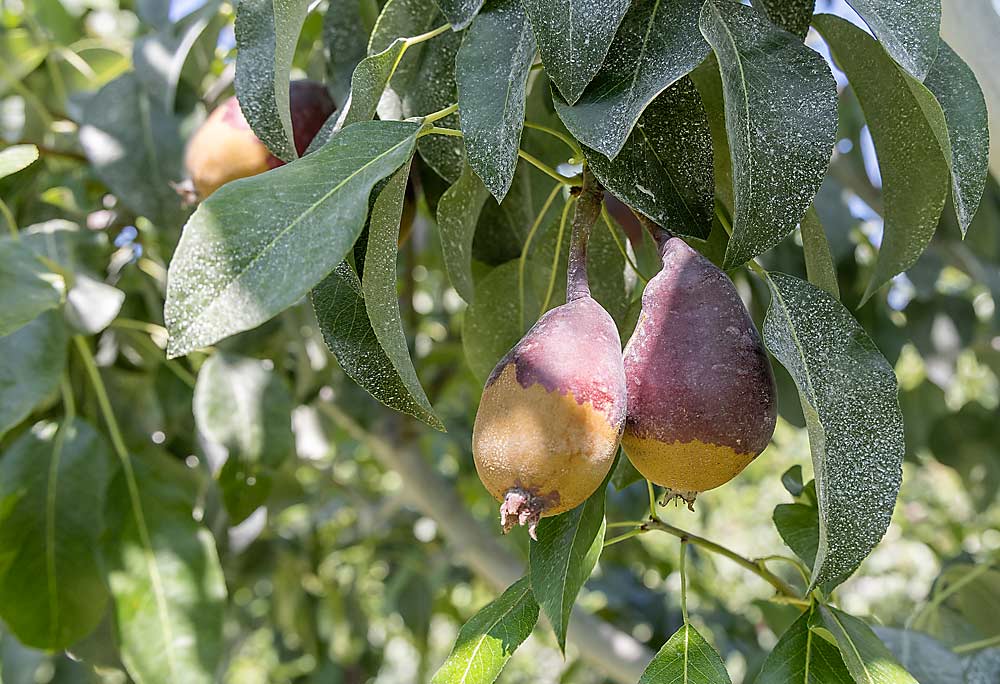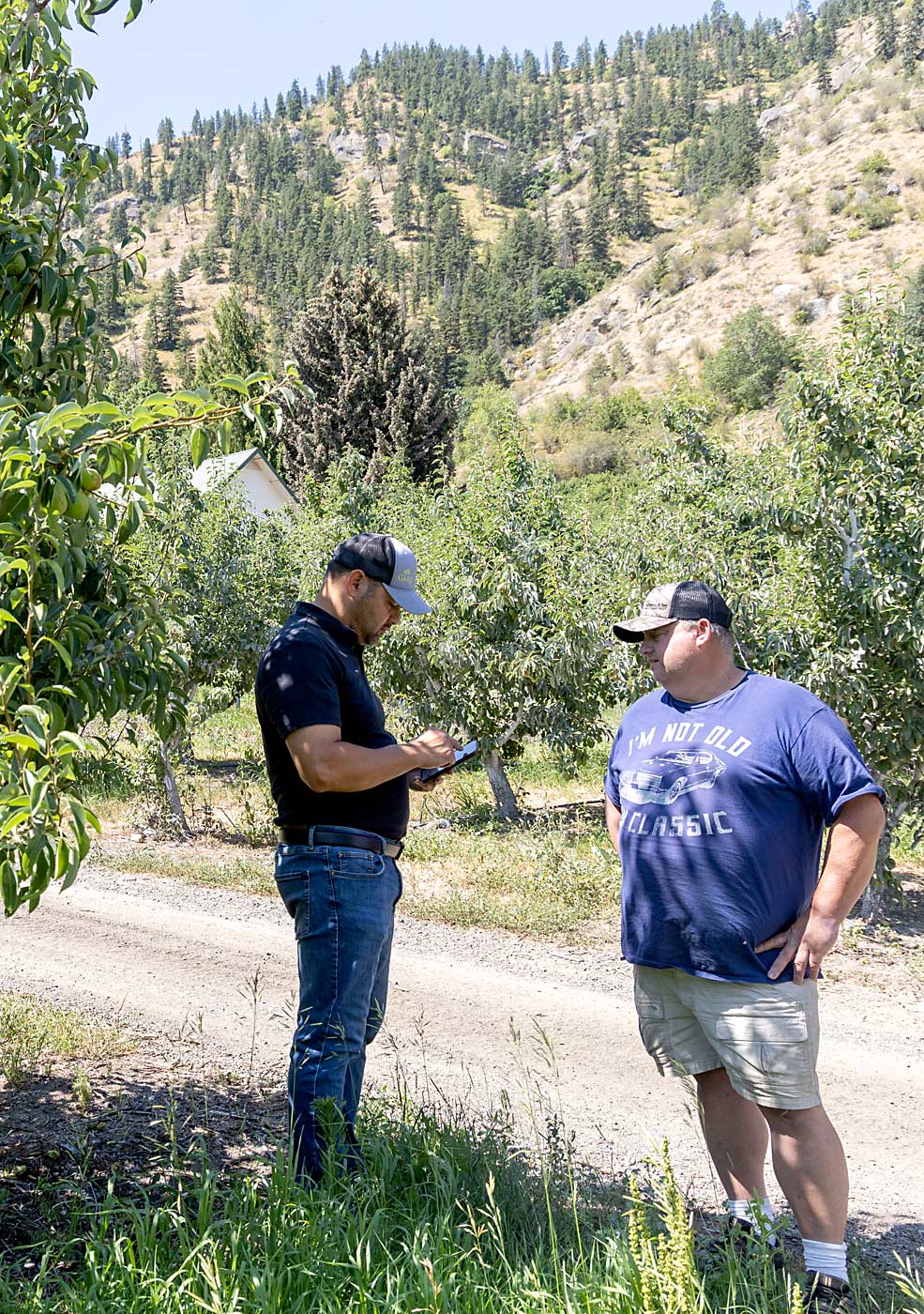—story by Ross Courtney
—photos by Kate Prengaman

Three weather events in the past two years have ganged up on Northwest pear growers to cut the projected pear harvest to its smallest volume in 40 years, casting an uncertain haze over harvest and marketing strategies.
They also weigh on growers’ hearts.
“We’ve spent a lot of time boosting each other up,” said Kevin Carney, a Cashmere, Washington, grower and Pear Bureau Northwest board member.
A formal crop estimate is slated for release in September, but growers and warehouses have spent the season so far making their own prognoses. For the Wenatchee district, those range anywhere from 30 percent loss to total loss, depending on location.
Meanwhile, there’s a strong crop in the Columbia Gorge and Yakima Valley growing districts, said Doug Gibson, CEO of Mount Adams Fruit.
The weather problems started back in fall 2022, when cold temperatures set in before the trees acclimated. The area’s growers well remember when the leaves didn’t fall from the trees.
The persisting leaves themselves didn’t hurt anything, and fruit set fine in spring 2023, said Ray Schmitten, general manager of Blue Bird Inc., a packing cooperative in Cashmere. But the cold damaged the buds that had started forming for the 2024 crop.
Then, in January this year, another arctic cold front brought five nights of below-zero temperatures, according to Washington State University’s AgWeatherNet. Cashmere set a record for minus 12 degrees Fahrenheit on Jan. 13. That damaged spur cambium to the point of not supporting any new flowers, Schmitten said. All areas of the Northwest felt the hit, with the worst damage occurring in British Columbia (see “A win-wine situation for Pacific Northwest industry”), but Washington’s pear losses centered on the higher elevations of the Wenatchee River Valley.
A few months later, in April, frost nipped many of the fruitlets that had managed to set, marking and scarring fruit to the point that canneries won’t even take it.

Uncertainty
The three events have left shippers and industry officials unsure of their plans. Low volume can mean higher pricing … to a point. The concern is losing retail shelf space and never getting it back.
That was one of the biggest points of discussion during industry meetings in May, when Pear Bureau Northwest set its annual budget. To compensate, the group that collectively promotes pears under a federal marketing order raised marketing assessments for the first time in 25 years.
Carney and Schmitten voted against the increase. Carney argued it was a bad year to raise any costs on growers. Schmitten wanted more discussion.
The small crop will affect pear promotions.
“It’s going to be an impact,” said Jeff Correa, international marketing director for Pear Bureau Northwest, which promotes fresh pears under the brand USA Pears. “There’s nothing you can do.”
The domestic market gets first dibs, Correa said. Then, the agency will probably leave full marketing budgets for Mexico and Canada, especially as the group ramps up promotions of red pears. Industry representatives think long-term opportunities exist for Starkrimson and Red Bartletts abroad, especially in Mexico.
For other regions, Correa’s team has reduced funding to “maintenance level,” just to keep up social media and trade meeting promotions, he said. That can change quickly though. Correa can direct more money for promotions in an Asian country, for example, once fruit is loaded onto a ship.
Production companies may rely on imports to fill shelf space.
“It’s probably the first time ever in my career I’m saying, ‘Thank God we have imports coming in,’” Schmitten said. Blue Bird sells fruit through Domex Superfresh Growers of Yakima.
Schmitten expects layoffs throughout the industry. Many growers canceled their H-2A contracts. On his own Wenatchee Valley farm, Schmitten brought in only four workers from his usual 16-man H-2A crew.
There are some bits of good news, he said.
The cool spring helped trees heal; fears of massive tree death did not pan out. Also, bud development for 2025 is “better than I expected,” Schmitten said.
Meanwhile, growers in the Wenatchee Valley are improving their integrated pest management techniques, building up populations of predators that mitigate pear psylla damage.
“That’s one of the bright spots in the pear future,” Schmitten said.

Emotional toll
Carney spent the season working with his insurance agents and farming a short and frost-scarred crop he wasn’t sure he was going to pick. When Good Fruit Grower talked with him in late July, he had not yet made any decisions.
Among the uncertainties: packing prices and picking costs.
Short crops also create challenges for warehouses, many of which are grower cooperatives. If they have less volume across which to share fixed costs, they may have to raise packing prices.
The light crop also may drive up labor costs or push piece-rate pickers to look for work elsewhere. Some growers may try to pay by the hour, but that’s typically less attractive to workers, too.
The whole situation is taking an emotional toll on growers in the Wenatchee Valley, Carney said. He drinks coffee every morning at the local Conoco station, where his friends candidly discuss mental health concerns and how to keep hope alive in terminology more stark than he has ever heard.
“It certainly is more stressful than a normal year,” he said. •







Leave A Comment